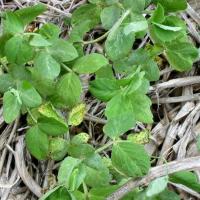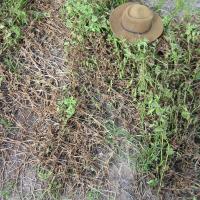Diagnosing blackspot in field peas
Blackspot is the most widespread and destructive disease of field peas in Western Australia.
What to look for
- The disease initially appears as small, dark, irregular flecks on leaves, stems and pods.
- Lesions enlarge in rainy and or humid weather and can show concentric rings in alternating shades of tan and brown. Spots on pods may coalesce to form large, sunken, purplish-black areas.
- Stem lesions enlarge to become long, wide streaks that are blue-black or purplish. These often join together too completely girdle stems, leaf stalks or tendrils and kill the plant.
- The disease damages the base of the stem and blights leaves, stems, pods and flowers.
- Infected seeds may be discoloured and appear purplish-brown. Lightly infected seed may appear healthy.
Plant
Where did it come from?

Contaminated stubble

Wet conditions
- Any one or combinations of three fungi may cause blackspot in field peas. All three can occur together and symptoms caused by each may not be easily distinguished from the other. The organisms involved are: Mycosphaerella pinodes - leaf spot, blight; Phoma medicaginis var. pinodella - foot rot; Ascochyta pisi - leaf and pod spot
- Mycosphaerella pinodes causes the most damage to field pea crops in Western Australia, and is the principal pathogen involved in nearly all occurrences of blackspot. Phoma medicaginis is occasionally found on infected stems of field pea. Ascochyta pisi is not common in Western Australia.
- The fungi can either be seed-borne, soil-borne, or survive in pea trash. It is able to survive in soil for several years, but at insufficient levels justify a soil test for blackspot fungi in WA. Soil-borne inoculum can cause severe root rot and lesions on the lower stem.
- Up to 45 per cent of seeds from areas receiving over 350 mm of rain per year may carry black spot infection, but seed from lower rainfall areas is almost free from infection. Seedlings grown from infected seed often die but there is no relationship between level of seed infection and disease development within the crop.
- The disease usually becomes established when spores of the fungi produced on old pea stubble, are carried into the new crop by wind. Infection may occur at any stage of plant growth.
- Mycosphaerella pinodes survives on pea stubble for more than three years, and produces airborne spores during each growing season, particularly in the first year and after the first rains. Spores released from fruiting bodies on the stubble following rain events as low as 0.2 mm can infect crops several kilometres away.
- During wet weather the disease may spread rapidly. Spores produced on infected plants are transferred onto adjacent healthy plants by wind and rain splash.
Management strategies
- Isolating the new crop from sources of infection and not sowing too early are the best methods of managing blackspot in field peas.
- Use the Blackspot Manager to determine optimum sowing time for blackspot control.
- Choose paddocks that have not grown field pea for at least 3 years and go no closer than 500 metres (m) to paddocks that grew field pea in the previous year. It is preferable to be at least 50m downwind of 2-3 year old stubbles, but no separation is necessary upwind.
- Fungicides applied as seed dressings, in-furrow fertiliser amendments or foliar sprays do not reduce disease nor increase yield sufficiently for them to be recommended for field pea production in Western Australia.
How can it be monitored?
- In South Australia a soil test has been used to predict disease risk in paddocks. In Western Australia it does not seem that Mycosphaerella pinodes survives in the soil at a sufficient level to justify a soil test for blackspot fungi.
See also
Further information
Where to go for expert help
Page last updated: Monday, 11 April 2016 - 3:30pm




